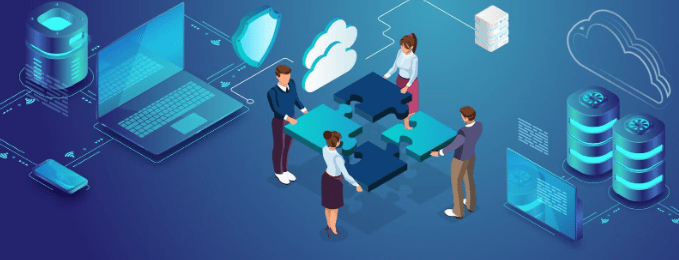Businesses increasingly turn to cloud migration services to propel their operations into the future. The integration of cloud technologies has become a pivotal force, revolutionizing how organizations manage and deploy their IT infrastructure.
But what does it truly take to master this digital evolution? In this comprehensive exploration, we delve into the insights from cloud migration experts, uncovering the nuances, challenges, and triumphs that define this transformative journey.

Learning Cloud Migration
Beginning on a cloud migration journey is more than just a technical transition; it’s a strategic move that reshapes the core of organizational functioning. To master digital evolution through cloud migration services, one must understand the intricacies of cloud migrations.
Cloud migration involves transferring data, applications, and infrastructure from on-premises servers to cloud-based platforms. The transition promises increased agility, scalability, and cost-efficiency, but achieving these benefits demands meticulous planning and execution.
The journey begins with a thorough assessment of the existing infrastructure. Experts emphasize the importance of a detailed inventory, identifying dependencies, and understanding the organization’s needs. This initial phase sets the stage for a seamless migration process, reducing the risk of disruptions and ensuring a smooth transition.
Key Aspects of Mastering Cloud Migration
- Strategic Planning for Seamless Migration
Successful cloud migration hinges on meticulous planning. Cloud experts stress the need for a comprehensive strategy that aligns with organizational goals.
This involves setting realistic timelines, defining key performance indicators (KPIs), and establishing a robust communication plan to inform all stakeholders throughout the migration journey.
- Data Security in the Cloud
Security remains a paramount concern for businesses transitioning to the cloud. Cloud migration experts prioritize implementing robust security measures, including encryption, identity management, and access controls.
Understanding the shared responsibility model is crucial, as it delineates the security responsibilities between the cloud service provider and the organization.
- Optimizing Performance and Scalability
One of the compelling reasons for cloud migration is the promise of enhanced performance and scalability. Cloud experts delve into optimizing applications and infrastructure, leveraging the cloud’s dynamic nature to scale resources up or down based on demand.
This ensures optimal performance and enables cost savings by paying only for the resources utilized.
- Ensuring Regulatory Compliance
Navigating the regulatory era is critical to cloud migration, especially for industries bound by strict compliance requirements.
Cloud migration experts guide organizations in understanding and adhering to industry-specific regulations, ensuring that data sovereignty and privacy concerns are addressed appropriately.
- Mitigating Downtime and Disruptions
The fear of downtime looms large during migration, and experts work diligently to minimize disruptions.
Employing phased migration, load balancing, and failover mechanisms, cloud migration experts ensure businesses can continue operations seamlessly, even during migration.
- Cost Management Strategies
While cost savings are a significant allure of cloud migration, managing expenses requires a strategic approach.
Cloud experts advise optimizing resource utilization, implementing cost monitoring tools, and adopting a pay-as-you-go model to align expenses with actual usage, preventing unnecessary financial strain.
- Training and Skill Development
Transitioning to the cloud necessitates a shift in skillsets. Cloud migration experts advocate investing in employee training programs to equip the workforce with the knowledge and skills to manage cloud-based infrastructure effectively.
This proactive approach ensures a smooth transition and fosters a culture of continuous learning within the organization.
- Monitoring and Performance Optimization
Post-migration, continuous monitoring becomes paramount. Cloud migration experts emphasize implementing monitoring tools and proactive measures to identify and address performance bottlenecks.
This optimization ensures that the cloud environment evolves with the organization’s changing needs.
Mastering Digital Evolution
| Key Aspect | Recommendations |
| Strategic Planning | – Define clear migration goals and timelines. |
| – Establish KPIs to measure the success of the migration. | |
| – Communicate transparently with all stakeholders throughout the process. | |
| Data Security | – Implement robust encryption and access control mechanisms. |
| – Understand and adhere to the shared responsibility model. | |
| – Regularly conduct security audits and assessments. | |
| Optimizing Performance | – Optimize applications and infrastructure for the cloud environment. |
| – Leverage auto-scaling to adjust resources dynamically based on demand. | |
| Regulatory Compliance | – Stay informed about industry-specific regulations. |
| – Implement measures to ensure data sovereignty and privacy compliance. | |
| Mitigating Downtime | – Use phased migration approaches to minimize disruptions. |
| – Implement load balancing and failover mechanisms. | |
| Cost Management | – Optimize resource utilization to avoid unnecessary expenses. |
| – Adopt a pay-as-you-go model to align costs with actual usage. | |
| Training and Skill Dev | – Invest in employee training programs for cloud-related skills. |
| – Foster a culture of continuous learning within the organization. | |
| Monitoring and Optimize | – Implement robust monitoring tools for continuous oversight. |
Final Words
Mastering digital evolution through cloud migration services is a multifaceted endeavor that demands strategic planning, meticulous execution, and continuous adaptation.
By embracing the insights from cloud migration experts and navigating the complexities with precision, businesses can unlock the cloud’s full potential and stay at the forefront of the ever-evolving digital landscape.



